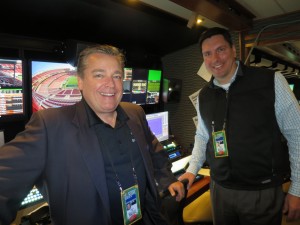SMT Takes Data Integration to New Heights for Super Bowl 50
Story Highlights
Super Bowl 50 was the culmination of a season-long effort by SMT (SportsMEDIA Technology) to deliver a robust system that could truly take the visualization of player tracking data and other information to the next level. And on Super Bowl Sunday CBS Sports took advantage of all of those efforts and even had more ways than ever to integrate it into the broadcast as 10 cameras (as opposed to just five for previous games) were configured to display the virtual line and other virtual graphics related to player matchups, situational success rates, and more

SMT’s Gerard Hall (left) and Don Tupper in front of the SMT system that is changing the way stats, video, and data are coming together.
The core of SMT’s technology is the DMX 2.0 football intelligence engine that is tied into the NFL’s player tracking data and then interprets it by using game events (like the snap of the ball) and the timecode of those events to marry it together and give context to the data.
“The magic is the event marking system,” says Gerard Hall, SMT founder, president, and CEO, as it brings together asynchronous data, events, and video. The conflux of live X, Y, Z data gathered by the NFL’s Zebra system from sensors in the player’s uniforms, live video content, and then non-live statistics that need to be input by a logger make the event marking system invaluable.
Don Tupper, SMT, VP of business development, says that by interpreting all of the data and stats the CBS Sports team can easily dive into everything like success rates for a given formation or down and distance, how often a player runs a certain route, or how they are involved in certain situations.
“For example, when a wide receiver is lined up against a corner back the user can cue the engine and see how many times those two players lined up against each other,” says Tupper. “The system recognizes patterns.”
The system also relies heavily on matching all of the data and stats to timecode to add in an additional layer of analysis.
“During the AFC Championship game we had speedometers on Peyton Manning and Tom Brady and we were able to provide a relevant story telling point,” adds Tupper.
Tupper says the ambitious plan to expand the tools available during the course of the season resulted in 20 weeks of delivering additional features and functionality.
“Each week we were delivering new features so it wasn’t overwhelming,” he explains. “And last week we were testing some new technologies for next season.”
Hall believes there is still plenty of growth opportunity for advances. The current use of next-generation stats in not only football but baseball and basketball requires a pause in the action as the announce team fires up a next-gen stat.
“You are going to see more merging of football intelligence into the screen space,” he says. A current example of that is the ability to bring up a statistic and then simultaneously insert a graphic identifying the players live on the screen.
“It’s the evolution from using stats as an event to something that just happens and helps the live storytelling,” he adds.
